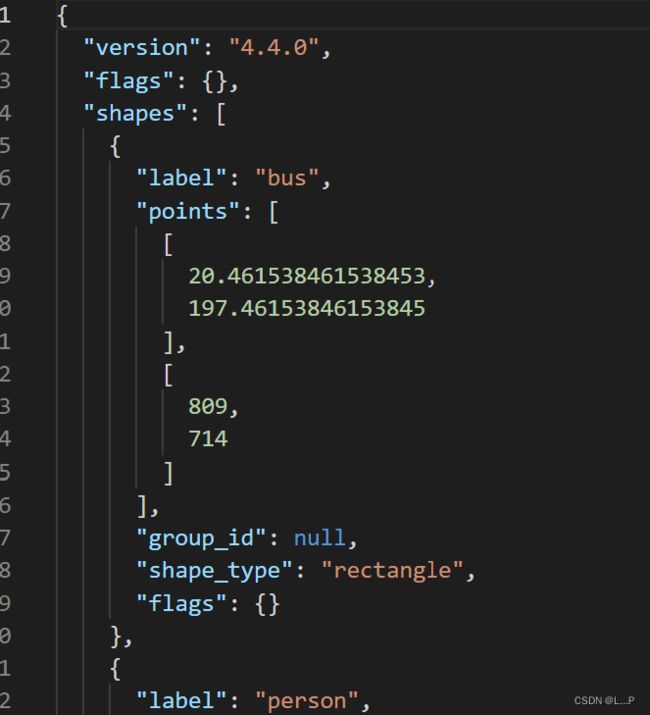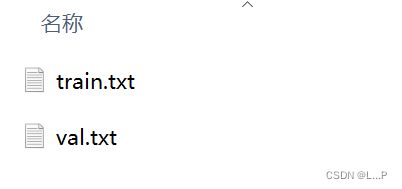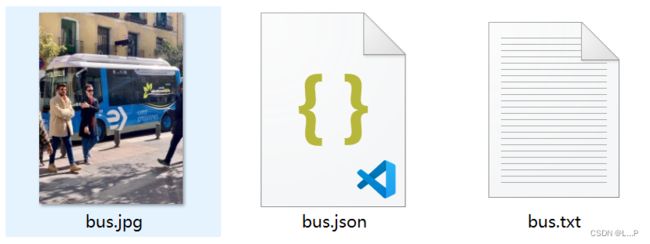YOLO-Fastestv2--训练自己的数据集
YOLO-Fastestv2介绍
YOLO-Fastestv2:
简单、快速、紧凑、易于移植;
资源占用少,单核性能出色,功耗更低;
更快更小:以 0.3% 的精度损失换取推理速度提高 30%,参数量减少 25%;
训练速度快,算力要求低;
训练流程:
一. 构建环境
1、从github clone代码到本地,在终端运行:
git clone https://github.com/dog-qiuqiu/Yolo-FastestV2.git
2、切换到Yolo-FastestV2路径下:
cd Yolo-FastestV2
3、并安装相关python依赖包:
# pip3 install -r requirements.txt
pip3 install -r requirements.txt -i https://pypi.mirrors.ustc.edu.cn/simple #采用国内源,速度较快
二. 准备数据
1、采集需要做检测的图像,利用labelme进行标注:
labelme标注实例:
结果: 得到图像以及对标注json文件;

2、json转换为YOLO-Fastestv2(yolov5)训练所需txt文件:
import os
import numpy as np
import json
import cv2
# 1、标注类别名称
classes = ["bus","person",]
labelme_path = r'.\images'
file_list = os.listdir(labelme_path)
files = []
for file in file_list:
if file.split(".")[-1] in ["jpg","png","bmp","jpeg","tif"]:
files.append(file)
def convert(size, box):
dw = 1. / (size[0])
dh = 1. / (size[1])
x = (box[0] + box[1]) / 2.0 - 1
y = (box[2] + box[3]) / 2.0 - 1
w = box[1] - box[0]
h = box[3] - box[2]
x = x * dw
w = w * dw
y = y * dh
h = h * dh
return x, y, w, h
def yolo_json2txt(filex):
if not os.path.exists('./tmp/'):
os.makedirs('./tmp/')
list_file_train = open('./tmp/train.txt', 'w+')
list_file_val = open('./tmp/val.txt', 'w+')
for i, imagePath in enumerate(filex):
json_file_ = imagePath.split(".")[0]
json_filename = os.path.join(labelme_path, json_file_ + ".json")
if not os.path.exists(json_filename):
print(json_filename)
continue
json_file = json.load(open(json_filename, "r", encoding="utf-8"))
if i % 5 == 0:
list_file_val.write('%s/\n' % imagePath)
else:
list_file_train.write('%s/\n' % imagePath)
out_file = open('%s/%s.txt' % (labelme_path, json_file_), 'w')
height, width, channels = cv2.imread(os.path.join(labelme_path,imagePath)).shape
for multi in json_file["shapes"]:
points = np.array(multi["points"])
xmin = min(points[:, 0]) if min(points[:, 0]) > 0 else 0
xmax = max(points[:, 0]) if max(points[:, 0]) > 0 else 0
ymin = min(points[:, 1]) if min(points[:, 1]) > 0 else 0
ymax = max(points[:, 1]) if max(points[:, 1]) > 0 else 0
label = multi["label"]
if xmax <= xmin:
pass
elif ymax <= ymin:
pass
else:
cls_id = classes.index(label)
b = (float(xmin), float(xmax), float(ymin), float(ymax))
bb = convert((width, height), b)
out_file.write(str(cls_id) + " " + " ".join([str(a) for a in bb]) + '\n')
print(json_filename, xmin, ymin, xmax, ymax, cls_id)
if __name__ == '__main__':
yolo_json2txt(files)
结果:
训练集、测试集路径文件:

三. 开始训练
1、修改数据集路径:(data/coco.data文件)
[name]
model_name=coco
[train-configure]
epochs=40
steps=25,35
batch_size=512
subdivisions=1
learning_rate=0.001
[model-configure]
pre_weights=
classes=2
width=352
height=352
anchor_num=3
anchors=12.64,19.39, 37.88,51.48, 55.71,138.31, 126.91,78.23, 131.57,214.55, 279.92,258.87
[data-configure]
train=tmp/train.txt
val=tmp/val.txt
names=./data/coco.names
2、训练相关
python3 genanchors.py --traintxt ./tmp/train.txt # 计算适应数据集的anchors,将输出值替换coco.data中anchors
python3 train.py --data data/coco.data # 开始训练
python3 test.py --data data/coco.data --weights weights/coco-40-epoch-0.994063ap-model.pth --img ./image # 测试模型效果
python3 pytorch2onnx.py --data data/coco.data --weights weights/coco-40-epoch-0.994063ap-model.pth --output yolo-fastestv2.onnx # 将模型转为onnx模型
python3 -m onnxsim yolo-fastestv2.onnx yolo-fastestv2-sim3.onnx # 将onnx模型简化,之后可通过"https://convertmodel.com/#outputFormat=ncnn"转换为ncnn,部署Android端
---------更新中--------------
